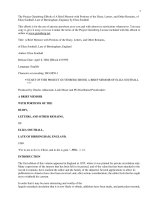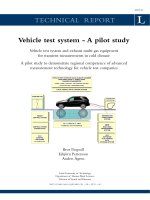2 BRIEF REPORT the impact of a pilot art intervention on the wellbeing of women who have experienced sexual violence
Bạn đang xem bản rút gọn của tài liệu. Xem và tải ngay bản đầy đủ của tài liệu tại đây (4.8 MB, 15 trang )
BRIEF REPORT:
Evaluation of the impact of a pilot art
intervention on the wellbeing of women
who have experienced sexual violence
JUNE 19 2020
Authored by: Pippa Grace, Nicola Holt & Emma
Halliwell
1
Workshops
Express yourself: Surviving to Thriving
In 2019 Somerset and Avon Rape and Sexual Abuse Support (SARSAS; www.sarsas.org.uk)
received an Express Grant of £4,300 from The Quartet Foundation (www.quartetcf.org.uk) to
run a pilot project offering creative workshops to women who have experienced sexual
violence. Many of these women were experiencing mental and physical health issues,
including social isolation, anxiety, depression, PTSD symptoms, chronic fatigue and chronic
pain. Several of the women had a ‘mental health diagnosis'. The pilot project, 'Express
Yourself: from Surviving to Thriving' ran at St Werburghs' Community Centre, Bristol, from
November 2019 – March 2020. Two groups of women received a series of four mixed media
workshops designed by artist Pippa Grace Robinson to provide a safe, secure, gentle
environment to help unlock and nurture their creative potential. Pippa was supported
throughout by Georgina Huntley, an art therapist working with SARSAS.
All participants received an entrance and exit interview with SARSAS and were supported by
SARSAS with any issues that arose during the workshops. The workshops aimed to:
Create a safe, secure, gentle environment.
Be mindful to use non-triggering language.
Set clear parameters around confidentiality and respect.
Create an inspiring space with a range of creative materials and activities accessible to
help unlock people's creative potential and a playful response to 'making'.
Use simple exercises to help people warm up and feel safe, and encourage them to
share their thoughts and feelings if they wanted to.
Encourage an atmosphere of positive support, respect and empathy.
Respond creatively and sensitively to the needs of each participant as they presented
at each workshop.
Adapt to any changes and challenges as necessary.
Monitor and evaluate the progress of the workshops as they took place and make any
changes needed week by week.
Document the workshops by taking photographs.
Improve the health, well-being and confidence of participants through creativity.
2
We ran two groups, each comprising the same four creative workshops. The four workshops
including the following activities:
Workshop 1: Personal Relationship to Creativity. Vision Mapping exercise using
collage with images and words from inspiring magazines, and other craft materials.
Workshop 2: Animal Qualities we Identify with. Clay workshop to create an animal
friend / soul animal, based on these qualities.
Workshops 3 & 4: Personal response to Safe / Calm Spaces. Mini mixed media project
over two weeks to find a creative response to this topic. Using: textiles, sewing,
knitting, collage, clay, cardboard boxes, paint, felt.
3
Evaluation
Participants
Twelve females took part in the evaluation of the art workshops, five in Autumn 2019 and
seven in Spring 2020. The average (mean) age was 41, participants ranging from 24 to 57
years of age. The average (mean) wellbeing score at the start of the workshops was 36.85
(scores ranging between 18 and 63), suggesting that, on average, participants’ scores were in
a range indicative of ‘probable depression’ (below 40).
Questionnaires
The Warwick-Edinburgh Mental Wellbeing Scale (WEMWBS; Tennant et al., 2007) consists of
14 questions that enquire about psychological wellbeing in the previous two weeks, such as
feeling connected to others, experiencing positive emotions, being able to think clearly and
having high self-esteem. A minimum ‘meaningful change’ in scores has been defined as an
increase of three points, and a score of 40 or less has been associated with depression,
and of 44 or less with possible depression.
The Short Mood Scale (SMS; Wilhelm & Schoebi, 2007). A six-item scale that measures:
hedonic tone or contentment (feeling content and happy rather than sad or depressed);
tense arousal (feeling anxious, tense and stressed rather than relaxed or calm); and energetic
arousal (feeling alert and energetic rather than sleepy and sluggish).
End of course evaluation scale (Wilson, Secker, Kent & Keay, 2017). A six-item scale enquiring
about the impact of arts for wellbeing course on aspects of wellbeing, including art skills,
motivation, positivity, confidence and relationships. It has a 4-item response scale ranging
from 1 = “not at all” to 4 = “yes, very much”.
4
Method
All participants were invited to take part in the evaluation and were able to read about what
this would involve in a Participant Information Sheet. Participants gave informed consent for
their data to be used for the evaluation. The evaluation received ethical approval from UWE’s
Ethics Committee. Participants were invited to complete a questionnaire at the first and final
workshop that asked about their general wellbeing (WEMWBS). Additionally, at the start and
end of each individual art workshop, they completed a mood scale (SMS) (following Holt,
2020).
5
Quantitative outcomes
Multi-level modelling was used to assess change in wellbeing and mood over time, since this
method allows for nested data, where, in this case, different measurement points (e.g. up to
eight mood reports) are nested within twelve individuals.
Wellbeing change
There was an increase in wellbeing on the Warwick-Edinburgh Mental Wellbeing Scale, from
week one to week four. The average (mean) wellbeing score at week one (week 2 for one
participant) was 36.85 (SD = 12.88) and at the end of the programme (week 4) the average
wellbeing score was 43.05 (SD = 9.92). The average wellbeing scores have increased by a
meaningful amount (six points) for a short intervention. Average scores are out of the range
of probable depression after four week, but are still in the range of possible depression. This
increase in WEMWB scores was statistically significant (F(1,9.28) = 12.35, p = .006).
It is worth noting that there is variation between individuals in wellbeing scores – with small
(3) to large (18) points of increase – and for one participant there was a decrease in wellbeing
(-3). Hence, not all participants appeared to benefit equally from the intervention. One factor
that might impact upon the efficacy of the intervention was attendance, since the change in
wellbeing was significantly predicted by attendance, B = -7.625, t = -2.221, p =.047, where
lower levels of attendance was associated with lower increases in wellbeing.
Mood change
In addition to assessing longer-term wellbeing, the immediate impact of taking part in the
workshops was assessed by tracking mood. There was a significant improvement on all three
dimensions of mood after taking part in the art workshops: a reduction in tension so that
participants reported feeling more relaxed (t = 6.64, p < .001); increased energy and alertness
(t = 6.24, p < .001); and increased contentment (t = 4.82, p < .001). All of these changes in
mood were statistically significant and mean changes are depicted in Figure One.
6
Figure One: Mood scores before and after taking part in the art workshops
Does mood change in the art workshops predict wellbeing change across the four-week
intervention?
An important question was to test whether any changes in mood during the art workshops
predicted longer term changes in wellbeing on the WEMWBS. Indeed, this was the case, the
extent to which mood improved during the art workshops, predicted the extent to which
wellbeing scores changed from week one to week. These relationships are illustrated in
Figures 2-4, below. In these figures, the green lines, which represent participants with big
increases in wellbeing, are steeper, showing that these participants had larger improvements
in mood after taking part in the art workshops. This was the case for all three dimensions of
mood, with statistically significant outcomes: reduction in anxiety and feeling calmer (B =
.379, t = 3.02, p =.004), as illustrated in Figure Two; feeling more content (B = .282, t = 2.84, p
=.006), as illustrated in Figure Three; and feeling more alert and energized (B = .360, t = 2.91,
p =.005) as illustrated in Figure four. These findings suggest that responses to the art
7
workshops can explain some of the change in wellbeing scores across the weeks, and
suggests that the art workshops directly impacted upon wellbeing.
Figure Two: Cross-level interaction plot, showing the change in calmness before and after
art workshops according to levels of wellbeing change across the programme (low, medium
and high increases in wellbeing)
8
Figure Three: Cross-level interaction plot, showing the change in contentment before and
after art workshops according to levels of wellbeing change across the programme (low,
medium and high increases in wellbeing)
Figure Four: Cross-level interaction plot, showing the change in alertness before and after
art workshops according to levels of wellbeing change across the programme (low, medium
and high increases in wellbeing)
9
Perceptions of impact of the art workshops on wellbeing
The final analysis related to participants’ evaluation of how the art workshops have impacted
on their everyday life: art skills, confidence, motivation, positivity and relationships with
others. The mean scores are illustrated in Figure 5, and show, on average, participants
concurred that the art workshops had positively impacted on these factors (especially
motivation to do artwork).
Figure Five: Participants mean responses on the art workshop evaluation scale
10
Qualitative outcomes
1) Many women reported enjoying feeling connected to other women in the group, and
becoming less socially isolated as a result:
" I have been struggling with depression and anxiety for several years. I have been
isolated in my flat & become so lonely. Need to make friends in a safe space. […]
(the group) was organised with safety in mind and I need this reassurance to be
able to attend something. Talking has helped and I know I'm not the only person
going through a hard time".
"Meeting new people is difficult but I wanted to try and socialise with people like
me"
"A safe space to come to has helped me leave the house on my own"
2) Participants benefitted from the opportunity to be creative and to bring the freedom of
this creativity into their lives:
"Freedom to be unique and CREATE! After years of being forced to be who I'm not.
Being able to create with freedom and validation is MEGA."
"Freedom to create. Being given an idea but being allowed to explore and
experiment. There were no right or wrongs so I felt more relaxed"
"I feel an empty place inside myself where I have no creativity any more but just
fear and despair. (I enjoyed) having materials just put out in front of me that I can
play with and not be judged."
3) There was no pressure to talk or share experiences, but participants found the creative
process could be cathartic.
11
I have found it helpful … "not talking about things but at the same time feel my
time here had a cathartic affect on me […] It was a very good experience, the start
of a new journey"
4) Participants found it helpful to identify with other women's experiences, and to
understand they were not alone in their life challenges and struggles:
"I'm longing to know that I'm not alone (not just that there are some lovely people
who care but also to be with others who – without saying anything – REALLY
understand because they KNOW – they've BEEN THERE!"
Conclusions and future directions
The quantitative outcomes suggest that the four-week long art intervention improved
participants’ self-reported wellbeing, with a meaningful mean increase of 6 points. This
wellbeing change was linked directly to the art workshops, since it was predicted by the
extent to which participants reported feeling more calm, content and alert at the end of
them.
These findings are extremely encouraging as they suggest that just four-weeks of arts
workshops can improve wellbeing. It is important to note that, although improved, at the end
of the intervention, participants wellbeing scores were indicative of possible depression.
However, it is impressive to see a meaningful change in just four weeks and we would expect
that a longer programme would lead to greater change. Therefore, future research should
examine whether a longer arts intervention can lift people out of the possible depression
band of wellbeing scores.
The intervention was very well received by participants, who rated the impact of the
intervention very positively. There was clearly variability in impact of this arts intervention on
women, with some women experiencing more dramatic benefits than others. Attendance
played a role in this. In addition, the responses to each individual session was important. The
extent to which individuals benefited from each workshop predicted the extent to which they
12
benefited across the intervention as a whole. This is important because looking at changes
experienced across each session can help identify, early on, which participants may need
additional support to maximise the impact of the arts intervention. Future research should
explore this possibility.
Overall, this research demonstrated that a short arts intervention can have a meaningful
positive impact on women’s well-being. Moreover, participants enjoyed these sessions and
felt that they had benefited from taking part. This is encouraging and indicates that arts
interventions are a relatively low cost, acceptable and effective intervention for this group.
The findings also support further development of this work to deliver longer interventions
and to consider using self-report tools to help maximise the benefit of arts interventions.
References
Tennant, R., Hiller, L., Fishwick, R., Platt, S., Joseph, S., Weich, S., ... & Stewart-Brown, S.
(2020). The Warwick-Edinburgh Mental Well-Being Scale. Health and Quality of Life
Outcomes, 5, 63.
Holt, N. J. (2020). Tracking momentary experience in the evaluation of arts-on-prescription
services: using mood changes during art workshops to predict global wellbeing change.
Perspectives in Public Health, 140(5), 270-276.
Wilhelm, P., & Schoebi, D. (2007). Assessing mood in daily life. European Journal of
Psychological Assessment, 23(4), 258-267.
Wilson, C., Secker, J., Kent, L., & Keay, J. (2017). Promoting mental wellbeing and social
inclusion through art: six month follow-up results from Open Arts Essex. International
Journal of Mental Health Promotion, 19(5), 268-277.
13
14
15









